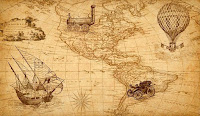The Way of a Ship is full of interesting facts about life on a four mast sailing vessel in the late 19th Century. It's also full of information about navigational practices used by captains to try to maintain a course and not run aground. And early in the book there's a great explanation of why sailing vessels were used for transporting coal around the world when steam-powered ships were already in service. As I read through those explanations I couldn't help but think of a list of questions based on the book, and 19th Century sailing in general, that could be brought into a mathematics class. In no particular order I've listed those questions below.
- Why were sailing ships used to transport coal if steam engine-powered ships (that burn coal) were available?
- How efficient does a steam engine have to be in order to make be able to carry enough coal to cross the Atlantic ocean while also being able to transport additional cargo? (Answer is in the book. Or email me if you want to know).
- What is the equivalent land distance of one minute of latitude?
- Why was it harder to calculate longitude than latitude?
- How did ship captains account for the difference between magnetic north and true north?
- How was speed calculated? What's the difference between 1 knot/hour and 1 mile/hour?
- If a late 19th Century commercial sailing vessel wanted to cover 300 nautical miles in a day, how strong of a tailwind would it need?
- Why was it less expensive for merchants to store coal on sailing vessels than in warehouses on shores?

